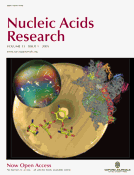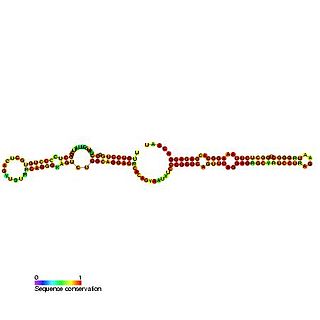
In molecular biology, Small Cajal body specific RNA 11 is a small nucleolar RNA found in Cajal bodies.
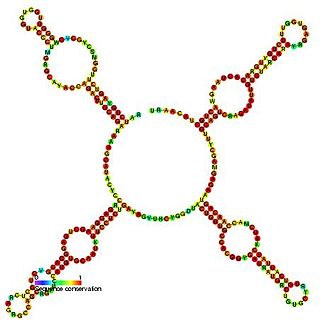
In molecular biology, Small Cajal body specific RNA 13 is a small nucleolar RNA found in Cajal bodies and believed to be involved in the pseudouridylation of U2 and U5 spliceosomal RNA.

In molecular biology, Small Cajal body specific RNA 14 is a small nucleolar RNA found in Cajal bodies.

Small Cajal body specific RNA 15 is a small nucleolar RNA found in Cajal bodies and believed to be involved in the pseudouridylation of U1 spliceosomal RNA.

Small Cajal body specific RNA 16 is a small nucleolar RNA found in Cajal bodies and believed to be involved in the pseudouridylation of U1 spliceosomal RNA.
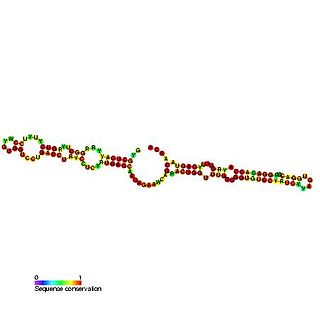
Small Cajal body specific RNA 23 is a small nucleolar RNA found in Cajal bodies and believed to be involved in the pseudouridylation of U1 spliceosomal RNA.

Small Cajal body specific RNA 24 is a small nucleolar RNA found in Cajal bodies and believed to be involved in the pseudouridylation of U6 spliceosomal RNA.

Small Cajal body specific RNA 8 is a small nucleolar RNA found in Cajal bodies and believed to be involved in the pseudouridylation of U2 spliceosomal RNA.
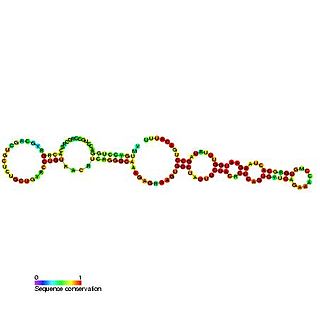
Small nucleolar RNA SNORA43 is a non-coding RNA (ncRNA) molecule which functions in the biogenesis (modification) of other small nuclear RNAs (snRNAs). This type of modifying RNA is located in the nucleolus of the eukaryotic cell which is a major site of snRNA biogenesis. It is known as a small nucleolar RNA (snoRNA) and also often referred to as a 'guide RNA'.
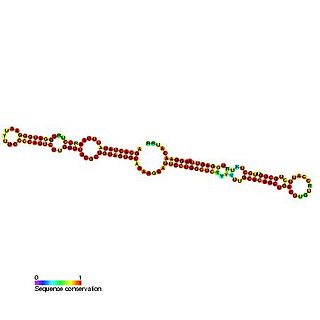
Small nucleolar RNA SNORA46 is a non-coding RNA (ncRNA) molecule which functions in the biogenesis (modification) of other small nuclear RNAs (snRNAs). This type of modifying RNA is located in the nucleolus of the eukaryotic cell which is a major site of snRNA biogenesis. It is known as a small nucleolar RNA (snoRNA) and also often referred to as a 'guide RNA'. ACA46 was originally cloned from HeLa cells and belongs to the H/ACA box class of snoRNAs as it has the predicted hairpin-hinge-hairpin-tail structure, has the conserved H/ACA-box motifs and is found associated with GAR1 protein. snoRNA ACA46 is predicted to guide the pseudouridylation of U649 of 18S ribosomal RNA (rRNA). Pseudouridylation is the isomerisation of the nucleoside uridine to the different isomeric form pseudouridine.

Small nucleolar RNA SNORA50 is a non-coding RNA (ncRNA) molecule which functions in the biogenesis (modification) of other small nuclear RNAs (snRNAs). This type of modifying RNA is located in the nucleolus of the eukaryotic cell which is a major site of snRNA biogenesis. It is known as a small nucleolar RNA (snoRNA) and also often referred to as a 'guide RNA'. ACA50 was originally cloned from HeLa cells and belongs to the H/ACA box class of snoRNAs as it has the predicted hairpin-hinge-hairpin-tail structure, has the conserved H/ACA-box motifs and is found associated with GAR1 protein. snoRNA ACA50 is predicted to guide the pseudouridylation of U34 and U105 of 18S ribosomal RNA (rRNA). Pseudouridylation is the to the different isomeric form pseudouridine.
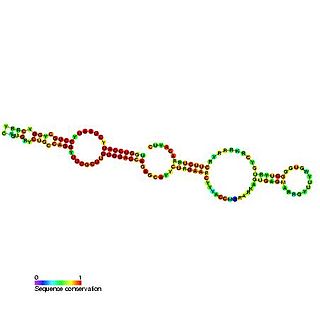
Small nucleolar RNA SNORA52 is a non-coding RNA (ncRNA) molecule which functions in the biogenesis (modification) of other small nuclear RNAs (snRNAs). This type of modifying RNA is located in the nucleolus of the eukaryotic cell which is a major site of snRNA biogenesis. It is known as a small nucleolar RNA (snoRNA) and also often referred to as a 'guide RNA'. ACA52 was originally cloned from HeLa cells and belongs to the H/ACA box class of snoRNAs as it has the predicted hairpin-hinge-hairpin-tail structure, has the conserved H/ACA-box motifs and is found associated with GAR1 protein. snoRNA ACA52 is predicted to guide the pseudouridylation of U3823 of 28S ribosomal RNA (rRNA). Pseudouridylation is the to the different isomeric form pseudouridine.
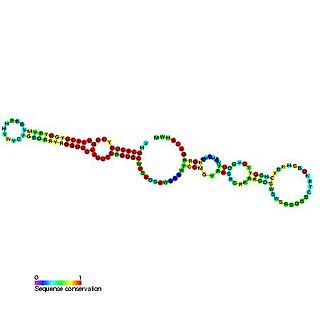
Small nucleolar RNA SNORA54 is a non-coding RNA (ncRNA) molecule which functions in the biogenesis (modification) of other small nuclear RNAs (snRNAs). This type of modifying RNA is located in the nucleolus of the eukaryotic cell which is a major site of snRNA biogenesis. It is known as a small nucleolar RNA (snoRNA) and also often referred to as a 'guide RNA'. ACA54 was originally cloned from HeLa cells and belongs to the H/ACA box class of snoRNAs as it has the predicted hairpin-hinge-hairpin-tail structure, has the conserved H/ACA-box motifs and is found associated with GAR1 protein. snoRNA ACA54 is predicted to guide the pseudouridylation of U3801 of 28S ribosomal RNA (rRNA). Pseudouridylation is the isomerisation to the different isomeric form pseudouridine.

Small nucleolar RNA SNORA55 is a non-coding RNA (ncRNA) molecule which functions in the biogenesis (modification) of other small nuclear RNAs (snRNAs). This type of modifying RNA is located in the nucleolus of the eukaryotic cell which is a major site of snRNA biogenesis. It is known as a small nucleolar RNA (snoRNA) and also often referred to as a 'guide RNA'. ACA55 was originally cloned from HeLa cells and belongs to the H/ACA box class of snoRNAs as it has the predicted hairpin-hinge-hairpin-tail structure, has the conserved H/ACA-box motifs and is found associated with GAR1 protein. snoRNA ACA55 is predicted to guide the pseudouridylation of U36 of 18S ribosomal RNA (rRNA). Pseudouridylation is the to the different isomeric form pseudouridine.
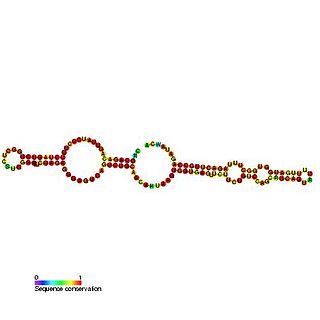
Small nucleolar RNA SNORA56 is a non-coding RNA (ncRNA) molecule which functions in the biogenesis (modification) of other small nuclear RNAs (snRNAs). This type of modifying RNA is located in the nucleolus of the eukaryotic cell which is a major site of snRNA biogenesis. It is known as a small nucleolar RNA (snoRNA) and also often referred to as a 'guide RNA'. ACA56 was originally cloned from HeLa cells and belongs to the H/ACA box class of snoRNAs as it has the predicted hairpin-hinge-hairpin-tail structure, has the conserved H/ACA-box motifs and is found associated with GAR1 protein. snoRNA ACA56 is predicted to guide the pseudouridylation of U1664 of 28S ribosomal RNA (rRNA). Pseudouridylation is the to the different isomeric form pseudouridine.
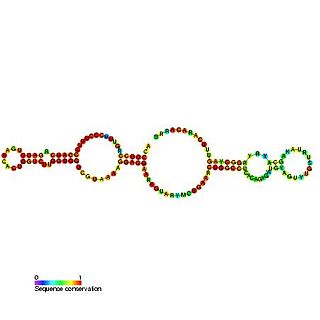
Small nucleolar RNA SNORA61 is a non-coding RNA (ncRNA) molecule which functions in the biogenesis (modification) of other small nuclear RNAs (snRNAs). This type of modifying RNA is located in the nucleolus of the eukaryotic cell which is a major site of snRNA biogenesis. It is known as a small nucleolar RNA (snoRNA) and also often referred to as a 'guide RNA'. ACA61 was originally cloned from HeLa cells and belongs to the H/ACA box class of snoRNAs as it has the predicted hairpin-hinge-hairpin-tail structure, has the conserved H/ACA-box motifs and is found associated with GAR1 protein. snoRNA ACA61 is predicted to guide the pseudouridylation of U2495 of 28S ribosomal RNA (rRNA). Pseudouridylation is the to the different isomeric form pseudouridine.

Small Cajal body-specific RNAs (scaRNAs) are a class of small nucleolar RNAs (snoRNAs) that specifically localise to the Cajal body, a nuclear organelle involved in the biogenesis of small nuclear ribonucleoproteins. ScaRNAs guide the modification of RNA polymerase II transcribed spliceosomal RNAs U1, U2, U4, U5 and U12.
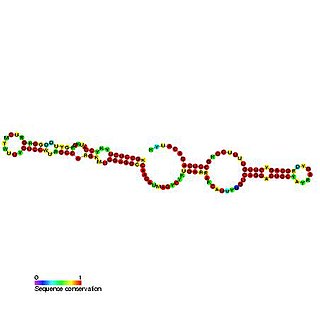
In molecular biology, Small Cajal body specific RNA 20 is a small nucleolar RNA found in Cajal bodies and believed to be involved in the pseudouridylation of U12 minor spliceosomal RNA.

Small nucleolar RNA SNORA77 is a non-coding RNA (ncRNA) molecule which functions in the biogenesis (modification) of other small nuclear RNAs (snRNAs). This type of modifying RNA is located in the nucleolus of the eukaryotic cell which is a major site of snRNA biogenesis. It is known as a small nucleolar RNA (snoRNA).
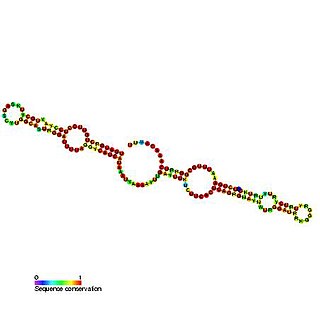
Small nucleolar RNA SNORA79 is a non-coding RNA (ncRNA) molecule which functions in the biogenesis (modification) of other small nuclear RNAs (snRNAs). This type of modifying RNA is located in the nucleolus of the eukaryotic cell which is a major site of snRNA biogenesis. It is known as a small nucleolar RNA (snoRNA).























